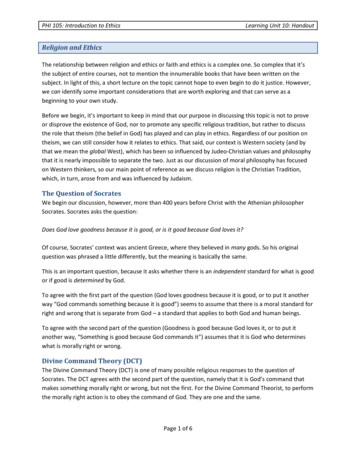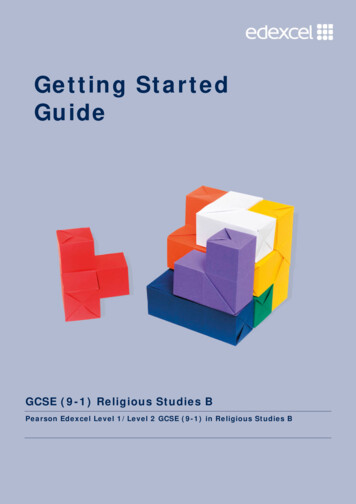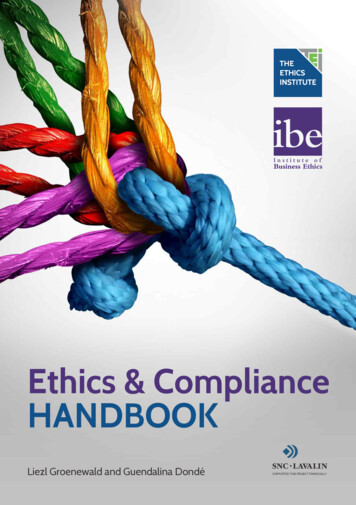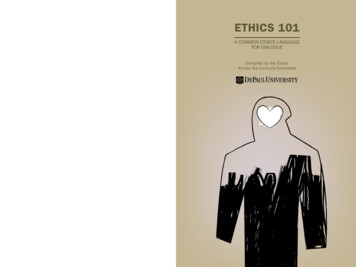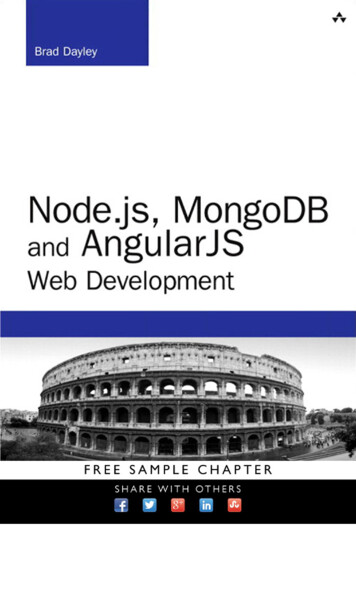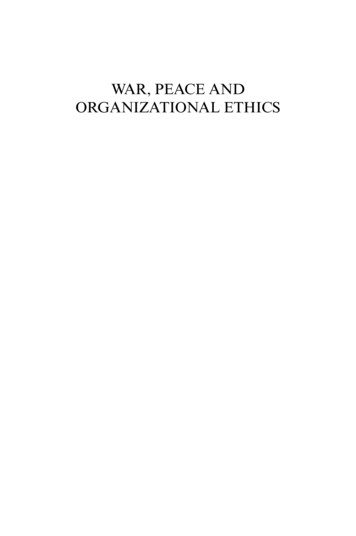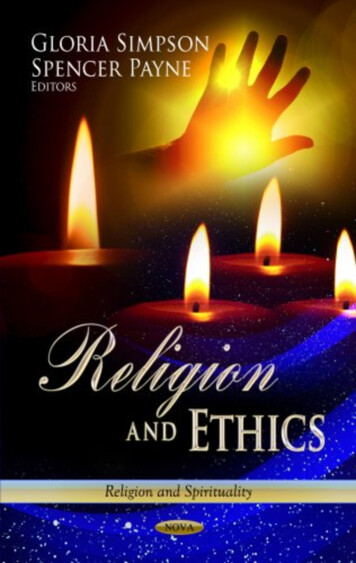
Transcription
In: Religion and EthicsEditors: G. Simpson and S. Paynepp. 73-97ISBN: 978-1-62257-813-9 2013 Nova Science Publishers Inc.Chapter 3THE EVERLASTING CONFLICTEVOLUTION-AND-SCIENCEVERSUS RELIGIOSITYGuillermo Paz-y-Miño-C*a and Avelina EspinosabaDepartment of Biology, University of Massachusetts Dartmouth,Dartmouth, MA, USAbDepartment of Biology, Roger Williams University, Bristol, RI, USAABSTRACTIn this chapter, we examine theoretically and quantitatively therelationship science-and-evolution awareness versus religiosity. For this, weuse a Cartesian landscape where the dependent variable acceptance ofevolution is plotted as function of three factors: religiosity or an individual’spersonal belief-convictions, level of understanding the essence of science,and familiarity with the concept of evolution. We contrast acceptance ofevolution among five United States (US) and international populations,including: university professors in various disciplines, an equally highlytrained group of specialized protisto-biologists, atheists, educators ofprospective teachers, and college students (Grand Total N 1,665participants in scientific online polling). We discuss evidence in support ofthe hypothesis that the controversy over evolution-and-science versusreligiosity is inherent to the incompatibility between scientific*gpazymino@umassd.edu
74The Everlasting Conflict Evolution-and-Science Versus Religiosityrationalism/empiricism and the belief in supernatural causation. We reportthat the levels of understanding of science and evolution by the faculty,protisto-biologists, educators, and students decreased with increasingreligiosity ( negative association of variables), and that the levels ofunderstanding evolution increased with increasing understanding of science( positive association of variables). Interestingly, the atheists, who had widerange of educational attainment and zero religiosity, had comparable levelsof understanding the foundations of science and evolution to the highlyeducated faculty and protisto-biologists. The educators and students were theleast knowledgeable about science/evolution and the most religious. Aftercomparing our findings with the patterns of acceptance of evolution in theUS and the world –and in the context of religiosity— we conclude that ifscience and religion co-persist in the future, the relationship between themwill fluctuate between moderate and intense antagonism.INTRODUCTIONThe controversy over evolution-and-science versus religiosity –the latterexemplified in this chapter by creationists views about the origin and evolution oflife on Earth, including Design Creationism or Intelligent Design, see Box 1— isinherent to the incompatibility between scientific rationalism/empiricism and thebelief in supernatural causation (Paz-y-Miño-C and Espinosa 2012a). Here weexamine this hypothesis theoretically and quantitatively by conceptualizing aCartesian landscape where the dependent variable acceptance of evolution isplotted as function of three factors: first, religiosity or an individual’s personalbelief-convictions; second, his/her level of understanding the essence of science(as method to explore reality); and third, his/her familiarity with the processes andforces of change in organisms (the concept of evolution). We contrast levels ofacceptance of evolution among samples of five populations of variableeducational attainment, including: (1) highly educated university professors ofNew England, United States (US); (2) an equally highly trained group ofspecialized international scholars in protistology –a subfield of biology dedicatedto the study of unicellular organisms that have a nucleus; the protistologists, asexpected, were particularly knowledgeable about science and evolution— nativeto 25 countries; (3) a group of atheists, non-believers and agnostics native to 35states in the US; (4) a group of educators of future educators –that is college anduniversity faculty specialized in training prospective teachers— from all 50 statesin the US; and (5) a representative group of college students from public, secularprivate, and religious institutions in New England, US.
The Everlasting Conflict Evolution-and-Science Versus Religiosity75Box 1. Evolution, Creationism, Design Creationism or Intelligent Design.Evolution.—The concept of evolution provides naturalistic explanations about the originof life, its diversification and biogeography, and the synergistic phenomena resultingfrom the interaction between life and the environment (Paz-y-Miño-C and Espinosa2011b); mutations, gene flow, genetic drift and natural selection shape life’s biologicalprocesses in Earth’s ecosystems (Mayr 2001). Since the publication of The Origin ofSpecies by Charles Darwin, in 1859, Darwinian evolution has been scrutinizedexperimentally; today the theory of evolution is widely accepted by the scientificcommunity (Coyne 2009; Dawkins 2009; Paz-y-Miño-C and Espinosa 2011a, b, 2012a).Creationism.—In contrast to evolution, creationism, theistic evolution, creation scienceor young-earth creationism (Petto and Godfrey 2007; Matzke 2010; Phy-Olsen 2010)rely on supernatural causation to explain the origin of the universe and life. These viewsare not recognized by scientists as evidence-based explanations of empirical reality(Padian 2009; Scott 2009; Paz-y-Miño-C and Espinosa 2009a, b, 2011a, b), or of cosmicprocesses which, according to modern understanding of “cosmic evolution,” doencompass the formation of the universe, the emergence of the simplest elements thattransformed into more complex elements and molecules, including prebiotic compoundsin our planet and that, ultimately, led to the evolution of molecular diversity andcomplexity of today’s living organisms and ecosystems (see Zaikowski et al. 2008;Krauss 2010; Paz-y-Miño-C and Espinosa 2011b, 2012a).Design Creationism or Intelligent Design.—The doctrine of ID, born in the 1980s,proposes that a Designer is responsible, ultimately, for the assemblage of complexity inbiological systems; according to ID, evolution cannot explain holistically the origin ofthe natural world, nor the emergence of intricate molecular pathways essential to life,nor the immense phylogenetic differentiation of life, and instead ID proposes anintelligent agent as the ultimate cause of nature (Pennock 2001; Young and Edis 2004;Forrest and Gross 2007a, b; Miller 2007, 2008; Petto and Godfrey 2007; Phy-Olsen2010). In conceptually mistaken, type-I-error-based arguments to discredit evolution, IDhas attributed randomness to molecular change, deleterious nature to single-genemutations, insufficient geological time or population size for molecular improvementsto occur, and invoked “design intervention” to account for complexity in molecularstructures and biological processes (Paz-y-Miño-C et al. 2011). In 2005, ID wasexposed in court (Dover, Pennsylvania, Kitzmiller et al. versus Dover School District etal. 2005; Padian and Matzke 2009; Wexler 2010) for violating the rules of science by“invoking and permitting supernatural causation” in matters of evolution, and for“failing to gain acceptance in the scientific community.” Today, “design creationism”(as we refer to ID due to its designer/creator-based foundations; Pennock 2001; Paz-yMiño-C and Espinosa 2010, 2011b; Paz-y-Miño-C et al. 2011a, 2012a) althoughdefeated by science and in the courts, grows influential in the US, Europe, Australia andSouth America (Cornish-Bowden and Cárdenas 2007; Padian 2009; Branch et al. 2010;Forrest 2010; Matzke 2010; Wexler 2010).
76The Everlasting Conflict Evolution-and-Science Versus ReligiosityThe over representation of New Englanders was deliberate, considering theirprogressive and liberal socio-political views (which allowed comparisons withtheir international protistologists counterpart, who were equally progressive, databelow) and public level of acceptance of evolution, 59%, which is the highest inthe US (The Pew Research Center for the People & the Press 2005). In addition,New England is the least religious region in the US, where 27% of its citizens are“very religious” (i.e. they state that religion is an important part of their daily lifeand attend religious services weekly) in contrast to an average 40% in the wholeUS (The Gallup Poll 2012).We selected the groups above to assess not only acceptance of evolution asfunction of the variables religiosity, science and evolution literacy, or as functionof differential education level (from professors in diverse disciplines to collegestudents), but also in association with zero religiosity, represented by the views ofatheists, non-believers and agnostics (all explicitly confirmed to their noreligiosity). Each of the five groups, therefore, represented a data point forcomparative analysis and also served as a control of group attributes. Forexample, the professors of New England, the protistologists, and the educators ofprospective teachers represented highly educated audiences in multiple fields ofexpertise ( New England faculty in 40 research-based disciplines within a singlenationality and/or country of residence; protistologists in a single field of researchfrom multiple nationalities and/or countries of residence; educators of prospectiveteachers in a non-science field, in 32 education specializations, and within a singlenationality and/or country of residence); the atheists, non-believers and agnostics( in a range of educational attainments, mostly outside academia, and within asingle nationality and/or country of residence); and the students ( within a rangeof college educational levels, from freshman to senior, within a single nationalityand/or country of residence). The profiles of these five populations have beenextensively discussed in our previous publications (Paz-y-Miño-C and Espinosa2012a, b; 2011a; 2009a, b).CONCEPTUAL AND QUANTITATIVE ASSESSMENT OFACCEPTANCE OF EVOLUTION AS FUNCTION OF THREEVARIABLES: RELIGIOSITY, SCIENCE AWARENESS, ANDEVOLUTION LITERACYIn a previous study (Paz-y-Miño-C and Espinosa 2012a), we plotted thedependent variable acceptance of evolution in a three-dimensional Cartesian
The Everlasting Conflict Evolution-and-Science Versus Religiosity77coordinate landscape where the independent variables, personal religiousconvictions, understanding how evolution works, and understanding the essenceof science, occupied the axes x, y, and z, respectively (Figure 1). The point zero,from which the coordinates originate, corresponds to a low (labeled none)religiosity, evolution, or science awareness condition, or a no awareness corner,which is a low probability of occurrence corner (LPC). Away from zero, the tipsof the coordinates’ arrows correspond to a high or deep religiosity, evolution, orscience awareness. The highest acceptance of evolution corner is located in thetop right of the landscape, where religiosity is low or none and evolution andscience awareness are high or deep. The lowest acceptance of evolution corner islocated in the bottom left of the landscape, where religiosity is high or deep andevolution and science awareness are low or none. A potentially highest personalconflict corner resides at the intersection of high or deep religiosity and evolutionand science awareness; this potential conflict condition, however, can be resolvedby an individual adopting self-comforting positions, such as: evolution andcreationism are in harmony, non-overlapping magisteria (NOMA the view thatscience and religion occupy separate domains; as in Gould 1999), or declaringagnosticism ( doubting about the existence or nonexistence of a deity). Note thatfour other corners are labeled LPC in Figure 1 due to their low probability ofoccurrence (e.g. high or deep understanding of science combined with nounderstanding of evolution and no religiosity, which is unlikely; after Paz-yMiño-C and Espinosa 2012a).To quantitate the levels of religiosity, understanding of science and theevolutionary process and plot them according to the parameters depicted inFigure 1, we (Paz-y-Miño-C and Espinosa 2011a, 2012a, b) have used threedescriptive indexes as characterizers of acceptance of evolution (each rangingfrom 0 to 3; least to most religious or knowledgeable about science or evolution):Religiosity Index RI (after The Pew Global Attitudes Project 2007), Science IndexSI and Evolution Index EI (both after Paz-y-Miño-C and Espinosa 2011a, 2012a,b). These indexes are powerful predictors of religious views worldwide (47countries; The Pew Global Attitudes Project 2007) and of levels of understandingscience and the evolutionary process (e.g. sample of 1,665 US and internationaladults with diverse academic backgrounds, from college students to universityprofessors; Paz-y-Miño-C and Espinosa 2011a, 2012a, b, this chapter). Eachindex relies on examining responses to simple, informative questions: ReligiosityRI: 1 if responders believe that faith in God is necessary for morality, 1 ifreligion is very important in their lives, and 1 if they pray daily. Science SI: 1 ifresponders reject the idea that scientific theories are based on opinions byscientists, 1 if they disagree with the notion that scientific arguments are as valid
78The Everlasting Conflict Evolution-and-Science Versus Religiosityand respectable as their non-scientific counterparts, and 1 if they reject thestatement that crime-scene and accident-scene investigators use a different type ofscientific method to investigate a crime or an accident; Evolution EI: 1 ifresponders reject the idea that organisms acquire beneficial traits during theirlifetimes and then pass on these traits to their descendants, 1 if they disagreewith the notion that during evolution monkeys such as chimpanzees can turn intohumans, and 1 if they reject the statement that the origin of the human mind andconsciousness cannot be explained by evolution.Figure 1. Theoretical three dimensional landscape where acceptance of evolution isdepicted as function of religiosity, science awareness, and evolution literacy. The pointzero corresponds to low/none personal religious convictions, understanding how evolutionworks, or understanding of the essence of science; zero is a no awareness corner, with lowprobability of occurrence (LPC). The tips of the coordinates’ arrows correspond to ahigh/deep religiosity, evolution, or science awareness. The highest acceptance of evolutioncorner (top right) is characterized for its low religiosity and high/deep evolution andscience awareness. The lowest acceptance of evolution corner (bottom left) ischaracterized by its high religiosity and low evolution and science awareness. Apotentially highest personal conflict corner resides at the intersection of high or deepreligiosity and evolution and science awareness; this conflict condition can be resolved bythe individual adopting comforting positions, such as: evolution and creationism are inharmony, non-overlapping magisteria ( science and religion occupy separate domains), oragnosticism (doubt about the existence or nonexistence of a deity). Other corners are alsolabeled LPC due to their low probability of occurrence (modified from Paz-y-Miño-C andEspinosa 2012a, Journal of Eukaryotic Microbiology, with permission).
The Everlasting Conflict Evolution-and-Science Versus Religiosity79APPLYING THE RI, SI AND EI CARTESIAN LANDSCAPE TOFIVE POPULATIONSIn Figure 2, we summarize the results of using this index approach to assessthe patterns of acceptance of evolution as function of RI, SI and EI among the fivepopulations mentioned above, which summarized profiles were (demographicdetails of each population are provided in Paz-y-Miño-C and Espinosa 2012a, b;2011a; 2009a, b): 244 New England faculty (93% PhD/doctorate holders in 40disciplines across 35 colleges and universities), 50 international protistologists(70% Ph.D./doctorate holders), 133 atheists, non-believers and agnostics (28%bachelors degree, 26% masters, 20% Ph.D./doctorate holders, 13% associate ortechnical degrees, 7% high school degree, and 6% professional degrees), 411 USeducators of prospective teachers (85% Ph.D./doctorate holders in 32 educationspecializations), and 827 New England college students (freshman 26.3%,sophomore 24.3%, junior 23.6%, senior 25.8%; who were enrolled at three typesof institutions: public 21.0%, secular private 50.5%, and religious 28.5%).Note that although participants in our online surveys were asked to not skipquestions, they could do it freely ( human subjects/Institutional Review Policiesacross institutions that granted permission to our studies); therefore, the totalnumber of responders (N values) per group and per survey topic, which is reportedin Figures 2 to 6, can vary; this should be evident when comparing among figurecaptions.The New England faculty held the highest acceptance of evolution position asfunction of RI, SI and EI (Figure 2): 94% indicated to accept evolution openlyregardless of others opinions and 82% thought that evolution is definitely true (RI 0.49; SI 2.49; EI 2.49), followed by the atheists (93% and 90%; RI 0.00;SI 2.34; EI 2.41), the protistologists (92% and 82%; RI 0.46; SI 2.30; EI 2.48), the educators of prospective teachers (72% and 63%; RI 1.31; SI 1.98;EI 1.77), and the students (63% and 58%; RI 0.89; SI 1.80; EI 1.60).When analyzing these patterns in more detail, we found –and this wasnoteworthy in respect to the atheists— that the levels of understanding thefoundations of science and evolution among the professors, the atheists and theprotistologists were statistically similar and higher than the educators’ or thestudents’ (Figure 3a and b); note that the latter two groups were statisticallyindistinguishable from one another. Although not surprisingly the atheists’, nonbelievers’ and agnostics’ religiosity was zero, the protistologists and NewEngland faculty were the next least religious groups, followed by the educators of
80The Everlasting Conflict Evolution-and-Science Versus Religiosityprospective teachers, and the students (Figure 3c). Remarkably, the educatorswere significantly more religious than the students.Figure 2. Acceptance of evolution plotted as function of religiosity (RI), science (SI), andevolution (EI) indexes. Each index ranges from 0 to 3 (least to most religious orknowledgeable about science or evolution; see text for details). The three-dimensionallandscape is consistent with the theoretical parameters depicted in Fig. 1; note, however,that in this Figure the scale of each dimension differs to enhance the display of data. TheNew England faculty held the highest acceptance of evolution position (N 244; RI 0.49; SI 2.49; EI 2.49), followed by atheists (N 133; RI 0.00; SI 2.34; EI 2.41),protistologists (N 50; RI 0.46; SI 2.30; EI 2.48), educators of prospective teachers(N 411; RI 1.31; SI 1.98; EI 1.77), and students (N 827; RI 0.89; SI 1.80; EI 1.60). Percentage values written within brackets correspond to responders admitting toaccept evolution openly regardless of others opinions (first value), or thinking thatevolution is definitely true (second value).
The Everlasting Conflict Evolution-and-Science Versus Religiosity81Figure 3. Understanding-of-science, evolution and religiosity indexes of New Englandfaculty (NE Fac), atheists, protistologists (Protistol), educators of prospective teachers(Edu) and college students (Stu). Each index ranges from 0 to 3 (lower to higher levels ofunderstanding of science and evolution, or least to most religious position) as follows: a,for the understanding-of-science index, responders received 1 if they rejected the ideathat scientific theories are based on opinions by scientists, 1 if they disagreed with thenotion that scientific arguments are as valid and respectable as their nonscientificcounterparts, and 1 if they rejected the statement that crime-scene and accident-sceneinvestigators use a different type of scientific method to investigate a crime or an accident;Kruskal-Wallis one-way ANOVA on ranks, H 119.336, df 4, P 0.001. b, for theevolution index, responders received 1 if they rejected the idea that organisms acquirebeneficial traits during their lifetimes and then pass on these traits to their descendants, 1 if they disagreed with the notion that during evolution monkeys such as chimpanzeescan turn into humans, and 1 if they rejected the statement that the origin of the humanmind and consciousness cannot be explained by evolution; Kruskal-Wallis one-wayANOVA on ranks, H 262.282, df 4, P 0.001. c, for the religiosity index, respondersreceived 1 if they agreed with the idea that faith in God is necessary for morality, 1 ifthey accepted the statement that religion is very important in their lives, and 1 if theyadmitted to pray daily; Kruskal-Wallis one-way ANOVA on ranks, H 95.678, df 3,P 0.001 (N/A non-applicable for Atheists whose RI 0). Lowercase letters indicateDunn-test two-tail pair-wise comparisons within groups P 0.05. NE Fac, N 222;Atheists, N 133; Protistol, N 50; Edu, N 411; and Stu, N 576. Error bars arestandard errors.
82The Everlasting Conflict Evolution-and-Science Versus ReligiosityINDEX ASSOCIATIONS BETWEEN RELIGIOSITY, SCIENCEAWARENESS, AND EVOLUTION LITERACYThe five groups showed directionality in the association between indexes(Figure 4). Except for atheists, non-believers and agnostics, whose religiosity wasalways zero (RI 0; 100% of responders, Figure 3c), and science awareness andevolution literacy high (SI 2.34 and EI 2.41, respectively, 100% ofresponders, Figure 4b, g), the levels of understanding of science and evolution bythe New England faculty, protistologists, educators of prospective teachers, andstudents decreased with increasing religiosity ( negative association ofvariables); in contrast, the levels of understanding of evolution increased withincreasing understanding of science ( positive association of variables).The scale at which the SI and EI indexes decreased as function of increasingRI was in accordance with the high levels of understanding of science/evolution,and low religiosity, by the faculty and protistologists in respect to an intermediateand low levels of understanding of science/evolution, and high religiosity, by theeducators of prospective teachers and the students, respectively (first and secondrows, Figure 4). Analogously, the scale at which the EI index increased asfunction of SI was in accordance with the high understanding of science/evolutionby the faculty, atheists and protistologists, and the intermediate and low levels ofunderstanding of science by the educators of prospective teachers and thestudents, respectively (third row, Figure 4).Note as well the following pattern in Figure 4: in the context of SI versus RIcomparisons, the highest to lowest levels of understanding of science by thefaculty (NE Fac SI 2.59 to 2.0; 69.8% to 3.2% of responders; index R2 0.964,P 0.009; Figure 4a), protistologists (Protistol SI 2.31 to 1.33; 72.0% to 6.0%of responders; index R2 0.355, P 0.202; Figure 4c), educators of prospectiveteachers (Edu SI 2.15 to 1.57; 35.5% to 18.5% of responders; index R2 0.814,P 0.049; Figure 4d), and students (Stu SI 1.97 to 1.32; 53.5% to 12.3% ofresponders; index R2 0.969, P 0.007; Figure 4e) corresponded to the lowest tohighest levels of religiosity (RI 0.0 to 3.0) in each group, respectively.In the context of EI versus RI, the highest to lowest levels of understanding ofevolution by the New England faculty (NE Fac EI 2.53 to 2.0; 69.8% to 3.2% ofresponders; index R2 0.811, P 0.049; Figure 4f), protistologists (Protistol EI 2.56 to 1.33; 72.0% to 6.0% of responders; index R2 0.732, P 0.072; Figure4h),educators of prospective teachers (Edu EI 2.16 to 1.25; 35.5% to 18.5% ofresponders; index R2 0.986, P 0.003; Figure 4i), and students (Stu EI 1.67to 1.35; 53.5% to 12.3% of responders; index R2 0.894, P 0.027; Figure 4j)
The Everlasting Conflict Evolution-and-Science Versus Religiosity83corresponded to the lowest to highest levels of religiosity (RI 0.0 to 3.0) in eachgroup, respectively.Figure 4. Association between understanding-of- science, evolution and religiosity indexesof New England faculty (NE Fac), atheists, protistologists (Protistol), educators ofprospective teachers (Edu), and college students (Stu). The linear regressions depict theassociation between the 0-to-3 levels of: first row, science index versus religiosity index;second row, evolution index versus religiosity index; and third row, evolution index versusscience index for each of the subpopulations of responders (i.e., NE Fac: a, f, k; Atheists: b,g, l; Protistol: c, h, m; Edu: d, i, n; and Stu e, j, o); the inverse association between level ofunderstanding of science/evolution and level of religiosity (first and second rows), as wellas the direct association between level of understanding of evolution and level ofunderstanding of science (third row) are evident. Numbers above and below regressionlines correspond to index values and percent of responders per data point, respectively.Linear regressions one tail: a, R2 0.964, P 0.009; b, N/A; c, R2 0.355, P 0.202; d,R2 0.814, P 0.049; e, R2 0.969, P 0.007; f, R2 0.811, P 0.049; g, N/A; h, R2 0.732, P 0.072; i, R2 0.986, P 0.003; j, R2 0.894, P 0.027; k, R2 0.989, P 0.002; l, R2 0.503, P 0.145; m, R2 0.398, P 0.184; n, R2 0.986, P 0.003; and o,R2 0.996, P 0.0005. NE Fac, N 222; Atheists, N 133; Protistol, N 50; Edu, N 411; and Stu, N 576. Error bars are standard errors.Finally, in the context of EI versus SI, the lowest to highest levels ofunderstanding of evolution by the New England faculty (NE Fac EI 1.50 to2.68; 1.8% to 59.5% of responders; index R2 0.989, P 0.002; Figure 4k),
84The Everlasting Conflict Evolution-and-Science Versus Religiosityatheists, non-believers and agnostics (Atheists EI 2.0 to 2.48; 3.0 % to 49.6% ofresponders; index R2 0.503, P 0.145; Figure 4l), protistologists (Protistol EI 2.0 to 2.88; 2.0% to 48.0% of responders; index R2 0.398, P 0.184; Figure4m), educators of prospective teachers (Edu EI 1.35 to 2.04; 4.9% to 30.4% ofresponders; index R2 0.986, P 0.003; Figure 4n), and students (Stu EI 1.05to 1.92; 10.2% to 27.3% of responders; index R2 0.996, P 0.0005; Figure 4o)corresponded to the lowest to highest levels of understanding of science (SI 0.0to 3.0) in each group, respectively.In summary, the data presented in Figure 4 confirms that the higher the levelof understanding of science and evolution the lower the level of religiosity amongall responders, but remember the 0% religiosity among atheists and theircomparable science- and evolution-literacy levels to the professors and theprotistologists (Figure 3 and 4b, g). Likewise, the higher the level ofunderstanding of science the higher the level of understanding of evolution in allgroups (lower row Figure 4). Note that Figures 3a, b and 4b, g, l do not implythat atheists, non-believers and agnostics have equal training in the sciences orevolution as the highly educated scholars or educators, but simply that in thequestions reported here these groups were comparable, except for religiositywhich, among atheists, non-believers and agnostics, was always 0.0%.It is interesting, however, that the atheists, non-believers and agnosticsshowed the least steepness in the regression line between EI and SI (R2 0.503, P 0.145; Figure 4l), suggesting an intrinsically high understanding of bothevolution and science, consistent with and probably linked to their zero religiosity(data this chapter) and their pre-college household background characterized by astrong liberal-arts upbringing (see Paz-y-Miño-C and Espinosa 2009a, b). Notethat educational attainment was highly variable among atheists (28% bachelorsdegree, 26% masters, 20% Ph.D./doctorate holders, 13% associate or technicaldegrees, 7% high school degree, and 6% professional degrees) and below the NewEngland faculty, protistologists, and educators of prospective teachers (93%, 70%and 85% Ph.D/doctorate degree holders, respectively), which implies that theatheists’, non-believers’ and agnostics’ high acceptance of evolution had littleassociation with obtaining an advanced academic degree (opposite to all othergroups, below). Previous studies have documented high knowledge amongatheists not only about evolution (Paz-y-Miño-C and Espinosa 2012c, thischapter) but also about American history, literature, politics, the role of religion inpublic life, and awareness about world religions (The Pew Forum on Religion andPublic Life 2010).For the non-atheist populations, studies suggest that pro-evolution viewsstrongly correlate with level of formal education. For example, acceptance of
The Everlasting Conflict Evolution-and-Science Versus Religiosity85evolution in the US increases from the high-school- (20/21%), to the somecollege- (32/41%), college-graduate- (52/53%), post-graduate- (65/74%)(N NA/1,018; Brumfiel 2005; The Gallup Poll 2009), and university-professor levels(94%, data this chapter). Keep in mind that the average acceptance of evolutionby the US general public is 35-40% (Brumfiel 2005; Miller et al. 2006), whichcoincides with the population attaining only some college education (above). Onlythe US post-graduates in our studies of college students, educators of prospectiveteachers, and research faculty have levels of acceptance of evolution comparableto or higher than the general public in other industrialized and prosperous nationslike Iceland, Denmark, Sweden, France, Japan and the United Kingdom ( 7585%; Miller et al. 2006; see detailed discussion in Paz-y-Miño-C and Espinosa2011a).THE VIEWS OF THE NON-RELIGIOUSTo explore further the relationship bet
science and religion occupy separate domains; as in Gould 1999), or declaring agnosticism ( doubting about the existence or nonexistence of a deity). Note that four other corners are labeled LPC in Figure 1 due to their low probability of occurrence (e.g. high or deep understanding of science combined with no
